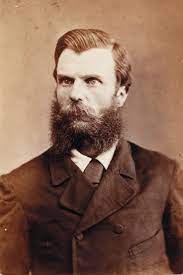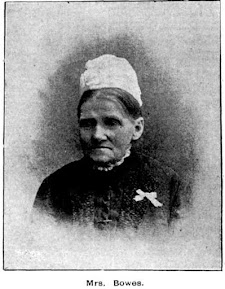Conman, Bushranger and Gay Icon
I like to keep my blogs relatively topical so as
Sydney is hosting World Pride it was decided a gay icon was needed and there
were a few candidates. I finally chose a man who was many things: conman, criminal,
bushranger as well as a gay icon.
ANDREW GEORGE SCOTT aka CAPTAIN MOONLITE
Scott was born in Ireland in mid 1842, the son of
Thomas Scott, an Anglican man of the cloth, and his wife Bessie. It is written
that Scott was a handsome, charismatic and intelligent child who, as a young
adult, was known for his impulsive acts of violence.
The family, including his younger brother Thomas
sailed to Auckland New Zealand on the “Black Eagle”. His father took charge of
Christ Church, Coromandel, and his brother was ordained a priest. Scott was a
teacher and entered the Auckland Militia in 1864 but in late 1867 he arrived in
Australia. In April 1868, he was appointed as a paid lay preacher of the Church
of Holy Trinity, Bacchus Marsh. Scott had grandiose plans to be an engineer but
in early 1869 he was sent as a lay reader to Egerton near Ballarat, where he
made friends with the local schoolmaster, James Simpson and Mr. Ludwig Julius Bruun,
Agent for the town’s branch of the London Chartered Bank. As Brunn was
returning to the Bank late on 8th May, Scott disguised in a mask and
cloak, attacked him and forced him to hand over the contents of the safe. Scott
then made Bruun write a note stating his resistance to the robbery; Scott
signed it with the moniker of “Captain Moonlite”.
Bruun claimed the man sounded like Scott, but no
evidence of the crime was found in Scott’s possession. Scott then accused Bruun
and Simpson of the crime who then became the focus of Police suspicion. Scott
took this opportunity to leave for Sydney as soon as possible.
Scott resigned his lay readership, bought some
horses, kept a groom and lived the high life. Towards the end of 1870 he begun
passing valueless cheques and fraudently bought the yacht “Why-Not”, arranged a
skipper and a young lady to accompany him but was arrested by the water police
as he tried to sail to Fiji. He was sentenced to twelve months in Maitland Gaol,
some his time being spent in Parramatta Lunatic Asylum, feigning madness.
During this sentence he was charged with the robbery of the Egerton Bank. Scott
received ten years hard labour and one year for escaping whilst on remand!
Whilst in Pentridge prison he gained the
reputation of being a great confident speaker and many of the younger
vulnerable men were drawn to him. Scott only served two-thirds of his sentence
and upon release was spotted frequently lecturing on the horrors of the justice
system accompanied by James Nesbitt, a young man he had met whilst on the
inside. He and James appeared to have a close relationship. Nesbitt, coming
from a home ruled by the drink and the fists of his father, was drawn to the
grandiose Scott. Scott in turn was no doubt flattered by the attention afforded
him by the quiet Nesbitt, who saw the older man as a somewhat “father” figure.
James Nesbitt - Wikipedia
During this time the authorities and tabloid press attempted to link Scott with all manner of unsolved crimes, and it would seem that he decided to live up to his reputation.
Scott assembled a gang of young men with Nesbitt
as his second. They were Thomas Rogan, Thomas Williams, Gus Wreneckie and
Graham Bennet. All had met Scott through his lecture tours and were, no doubt
impressed with his views, which appealed to displaced young men.
The gang commenced their careers as bushrangers
near Mansfield Victoria. They then travelled north across the border of NSW to
actually look for work, as whilst in the state of Victoria, Police surveillance
stopped any opportunity for legitimate employment.
Finding work in NSW was not as easy as Scott
thought and decided to hold up the Wantabadgery Station near Wagga Wagga in
November 1879, being refused work and on the point of starvation. Scott also
robbed the Australian Arms Hotel of alcohol and took prisoner the residents of
nearby properties, the number totalling twenty-five.
One man, Ruskin, attempted to escape but was soon
found. A party of four mounted troopers arrived but Scott’s gang captured their
horses and held them down with gunfire for several hours until they retreated
to get reinforcements.
At this time the gang then holed up in the
farmhouse of Edmund McGlede until surrounded by further Police reinforcement
led by Sergeant Carroll.
As Wreneckie was running from a fence to reach a
better position he was fatally shot. The Police gradually advanced and drove
the remaining gang members into the back kitchen. Sergeant Carroll led an
assault and during this attack Senior Constable Edward Webb-Bowen was fatally
wounded from a bullet fired by Scott.
From accounts it is believed at this stage that
Scott wanted “to go out all guns blazing” but was talked down by Nesbitt, who
when attempting to lead Police away from the house so Scott could escape was
fatally shot. When Scott witnessed this, he ran to the young man and whilst
distracted, McGlede disarmed him and with the other gang members wounded, the
fighting came to an end. Rogan managed to escape but was later found under a
bed in the house.
According to newspaper reports at the time, Scott
wept openly at the loss of his dearest companion, kissing him passionately and
souveniring a lock of Nesbitt’s hair which he later fashioned into a tight
curl to wear as a ring.
Scott denied shooting Webb-Bowen. Witnesses
stated that Scott was armed with a Snider rifle when the Policeman had died
from a bullet from a Colt pistol. Scott was found guilty nevertheless despite
deflecting as much guilt from his gang with the jury recommending mercy for
three of them.
Scott and Rogan were hanged together in Sydney at
Darlinghurst Gaol at 8am on 20th January 1880. Both were taken down
and buried in unmarked graves in Rookwood.
Scott wrote a series of letters whilst awaiting
his hanging. In them he pronounced his love for Nesbitt with his final wish to
be buried in the same grave as his companion.
“My dying wish is to
be buried beside my beloved James Nesbitt. The man with whom I was united by
every time which could bind human friendship, we were one in hopes, in heart
and soul and this unity lasted until he died in my arms.”.
So what happened next…
The Reverend Thomas Scott, Andrew George Scott’s
father, died in 1882 in NZ. He had changed his will three years earlier with no
mention of Andrew.
James Nesbitt’s father continued on a life of
crime and was in and out of gaol many times. He died in Melbourne Gaol in 1892.
An inquest heard he had a brain disease.
Thomas Williams was hanged in July 1885 for
attempting to murder a fellow prisoner in Parramatta Gaol. In his testimony amongst
other things, he stated that his life in serious crime started when he was led
astray by Captain Moonlite.
Graham Bennet whose death sentence had been
commuted to life imprisonment was released in late 1885. It is believed that a
letter written by Williams prior to his execution swayed the authorities.
The widow of Senior Constable Edward Webb-Bowen
had difficulties coming to terms with her husband’s death. She received a
pension and became a landlady in Double Bay. She moved to Adelaide and battled
problems with alcohol, dying alone in 1911.
In 1995, 115 years after his death and due to the
lobbying carried out by Christine Ferguson and Samantha Asimus, Scott’s remains
were exhumed and removed to Gundagai.
The funeral procession was carried out in
colonial period costume and Scott was laid to rest under an old gum tree as
close to the known whereabouts of Nesbitt’s grave whose exact components have
been lost in time.
Burial plot of Andrew George Scott at Gundagai Cemetery - Monument Australia with thanks
The plot where Scott was buried in Rookwood is marked by a plaque that states:-
ANDREW GEORGE SCOTT
CAPTAIN MOONLITE
Born Ireland
8-1-1845
Died Sydney
20-1-1880
As to a monument
stone a rough unhewn rock
Would be most fit,
one that skilled hands could
Have made into
something better. It will be like
Those it marks as
kindness and charity could have
Shaped us to better
ends.
Andrew George Scott
Laid to final rest
near his friends James Nesbitt and Augustus
Wernicke who lie in
unmarked graves close by.
Gundagai 13-1-1995
Although Scott is not an unknown or forgotten
person who once called Rookwood ‘home’, his legend lives on.
There are numerous references available about
Andew George Scott and his alter ego “Captain Moonlite” on Google, Trove and
the Australian Dictionary of Autobiography as well as many books.
A great book I have used as a reference is
“Moonlite” by Garry Linnell where the author has extensively covered all
aspects of Scott’s story. Thanks Garry it’s a great read! (It’s still in print
and available to buy at the usual outlets).
If you have any comments, please do so below or at
the group Facebook page under
rookwoodcemeterydiscoveries.blogspot.com
Or send me a personal email at
Until next week….







A very interesting read as usually but as I’ve seen the original grave this one I’ll certainly remember..Thanks Loraine…
ReplyDeleteThank you and boy Captain Moonlite was a character alright. Glad to see he's now at rest near his nearest and dearest
Delete